Abstract
This publication is part of the Wildlife of Florida fact sheet series, created to provide the public with a quick and accurate introduction to Florida’s wildlife, including both native and invasive species. We hope these fact sheets inspire you to learn more about one of Florida’s rarest mammals, the Key Largo woodrat, as well as investigate the other wildlife around your community and understand the amazing biodiversity in the state of Florida.
Breeding = Summer
Habitat = Tropical hammock.
Status = Endangered on both state and federal levels.
Scientific name: Neotoma floridana smalli
Common name: Key Largo woodrat
Habitat: Tropical hardwood hammocks of Key Largo.
Physical description: Adult Key Largo woodrats are medium-sized rodents with a body ranging from 4.7 to 9.1 inches long and a tail, typically shorter than the body, ranging from 5.1 to 7.5 inches long. Adults have gray-brown fur on their backs that blends into cinnamon-toned along their sides with cream-colored or white undersides (Figure 1). Their tails are lightly furred. Juveniles have dull gray fur on their backs and grow into the brown coloration upon reaching sexual maturity. Males are typically larger than females, but otherwise the sexes look similar.
Weight: Males average around 9.10oz (258g), while females average around 7.41oz (210g).
Reproduction: Gestation averages 35-40 days. Females have small litters, averaging two pups, once or twice a year. Juveniles reach sexual maturity within 4–5 months.
Lifespan: One to three years on average. Captive woodrats can live longer.
Dispersal & home range: Little is known about dispersal in Key Largo woodrats, but in other woodrat species dispersal distances of young more than 200 meters is rare. Adult Key Largo woodrats have a small home range, averaging less than one acre (0.76 acres or 3065 m2). Males tend to have a larger home range and travel farther than females.

Credit: Daniel Greene, The Wildlife Society Florida Chapter
Distribution
The Key Largo woodrat is a subspecies of the Eastern woodrat (Neotoma floridana). Though Eastern woodrats have a patchy distribution throughout the southeastern United States, Key Largo woodrats are restricted to only the northern third of the island of Key Largo in approximately 2100 total acres (8.5 km2) of habitat (Figure 2). This small area is largely undeveloped and contained within two protected conservation areas, Crocodile Lake National Wildlife Refuge and Dagny Johnson Botanical State Park.
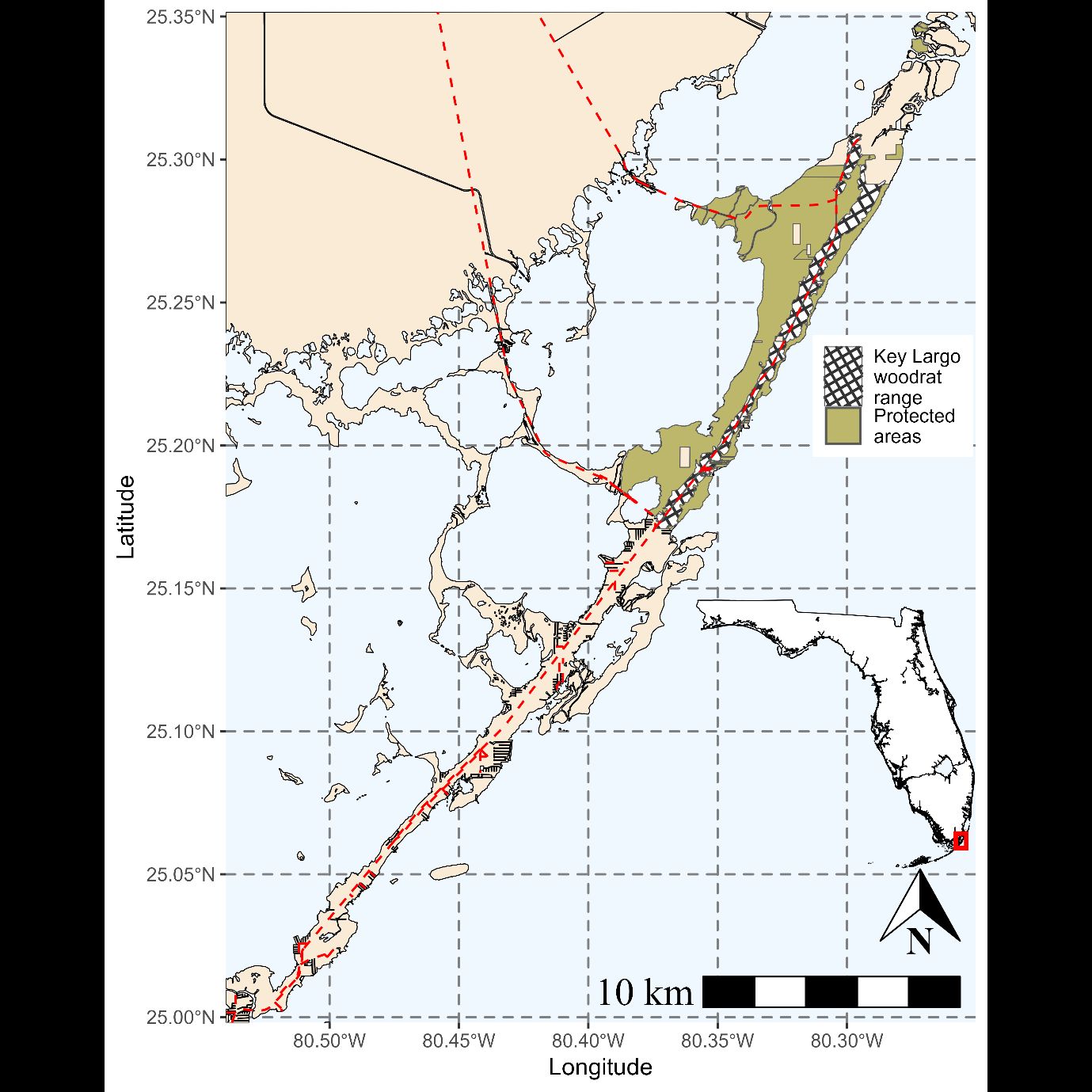
Biology and Behavior
Key Largo woodrats are nocturnal, relying on one or a small network of stick-nests as refuge during the day. Under the cover of night, they emerge to forage for food and perform maintenance on their stick-nests. Woodrats are ecosystem engineers, the stick-nests they construct can grow to be quite large over time Over multiple generations some have grown to sizes over six feet long and four feet high (Figure 3). A variety of other species, both vertebrates and invertebrates, use these stick-nests as a resource for shelter or food. If stick-nests are not maintained, they decompose and lose structural integrity over time, so woodrats continuously add new sticks (Figure 4).
The diet of the Key Largo woodrat consists of the fruit and leaves of a wide variety of hammock plants, including wild coffee (Psychotria nervosa), snowberry (Chiococca alba), pigeon plum (Coccoloba diversifolia), potato-tree (Solanum erianthum), blackbead (Pithecellobium keyense), and several species of fig (Ficus sp.). They will also occasionally consume insects. Sometimes woodrats bring fruits and seeds back to the nest and stored in a cache for later. They tend to stay relatively close to their nests when foraging or collecting sticks, often keeping to within 50–60 yards (approximately 50m) of the nest site.
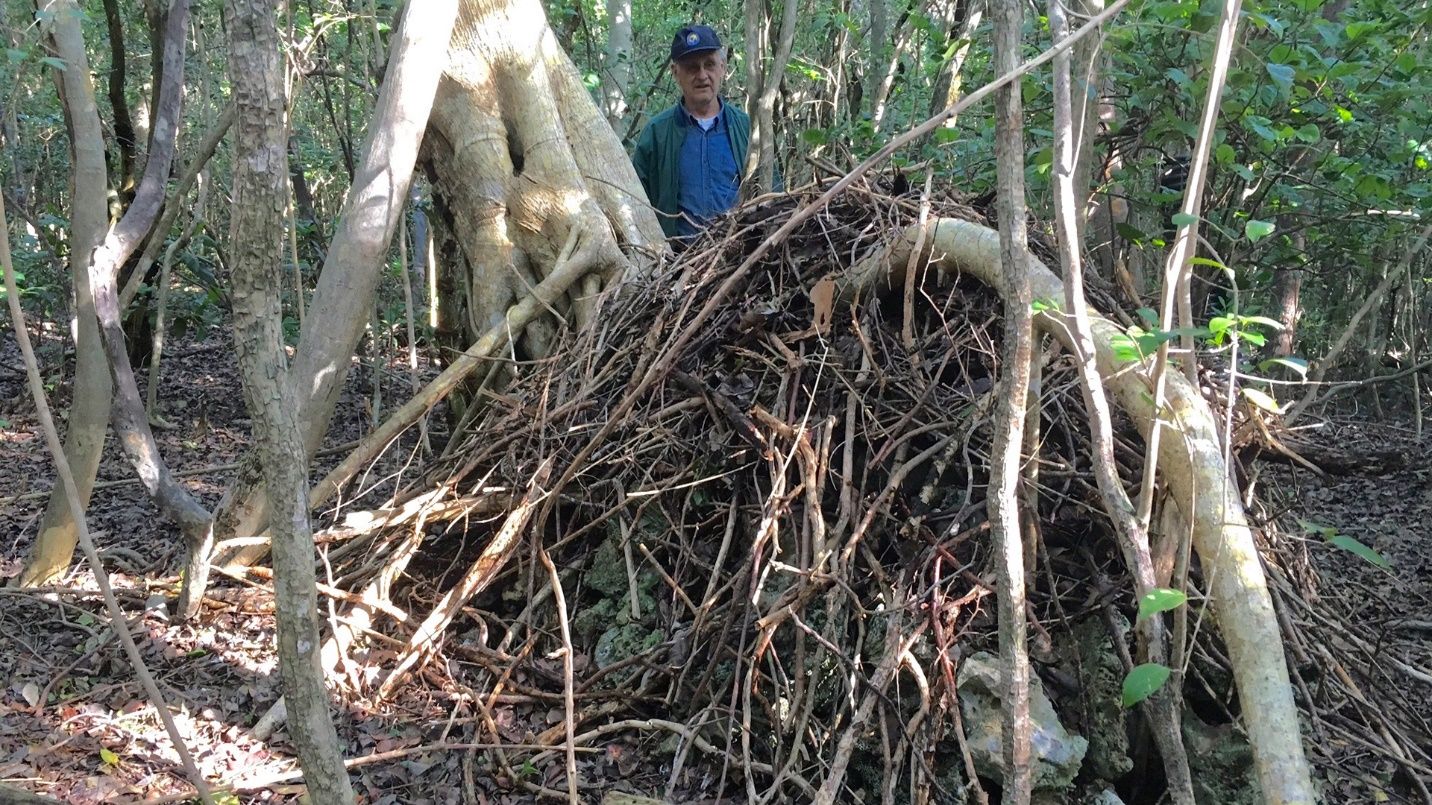
Credit: Clay DeGayner
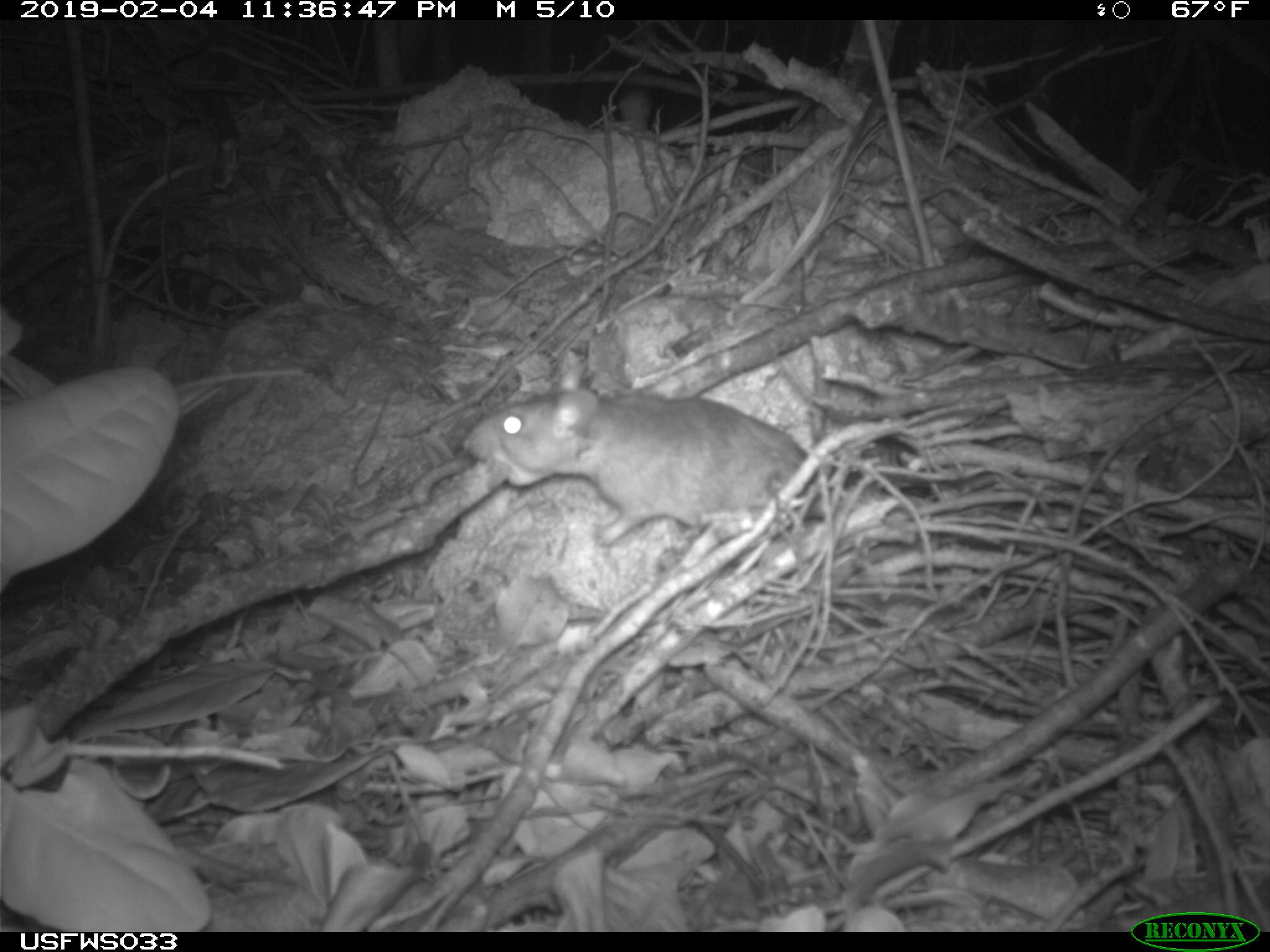
Credit: United States Fish and Wildlife Service
History
Key Largo woodrats were first described from observations on Key Largo in 1923 and declared a unique subspecies in 1955 based on morphological measurements. There is anecdotal evidence that they occurred across the island historically, but they appear to have been more common on the northern part of Key Largo, where they are still found today. An attempt was made in 1970 to establish a small group of captured woodrats further south within Lignumvitae Key Botanical State Park. However, despite some initial success, the introduced population had disappeared completely by the late 1990s. Reports from the 1980s indicated high densities of woodrats and numerous stick-nests, but only within a study area on the north side of Key Largo. Key Largo woodrats had been eliminated through the remainder of their previous range at this point, and were federally listed as endangered due to limited available habitat in 1983. Their population declined throughout the 1990s; by 2002, the population was estimated to be less than 100 individuals, and stick-nests were largely absent from the environment. A series of wildlife management efforts have been undertaken to prevent the extinction of the species since then. A captive breeding program was attempted but abandoned because of low survival of released individuals. The implementation of supplemental nest sites and removal of exotic predators has shown positive results for woodrat populations in recent years.
Threats
Small populations with limited available habitat are often at risk of extinction. As a result of historical agriculture and development, Key Largo woodrats are now restricted to the hardwood hammock in two protected areas on the north end of Key Largo that were established in the 1980s. While development is no longer a threat in those protected areas, a frequently used road and other developments and infrastructure still in place can act as barriers, fragmenting existing woodrat populations. Changes in soil moisture because of rising sea levels contribute to the transition of hardwood hammock into mangrove forest, which is unsuitable for woodrats.
The most immediate risks come from two introduced predators: domestic cats (Felis catus) and Burmese pythons (Python bivitattus). The stick-stacking behavior of woodrats is thought to leave them particularly vulnerable to predation. Management efforts have helped to remove cats within protected areas but have been less effective at reducing the number of pythons. In fact, signs indicate that python populations have been increasing in recent years. The direct influence of pythons is still under investigation, but research has demonstrated that domestic cats negatively impact Key Largo woodrats (Figure 5).
In addition to habitat loss and pressure from predators, species like the black rat (Rattus rattus) may be competing with woodrats for space and other resources, particularly when closer to the edges of protected areas near development. As in the case of pythons, more research is needed to determine whether black rats directly influence Key Largo woodrats.
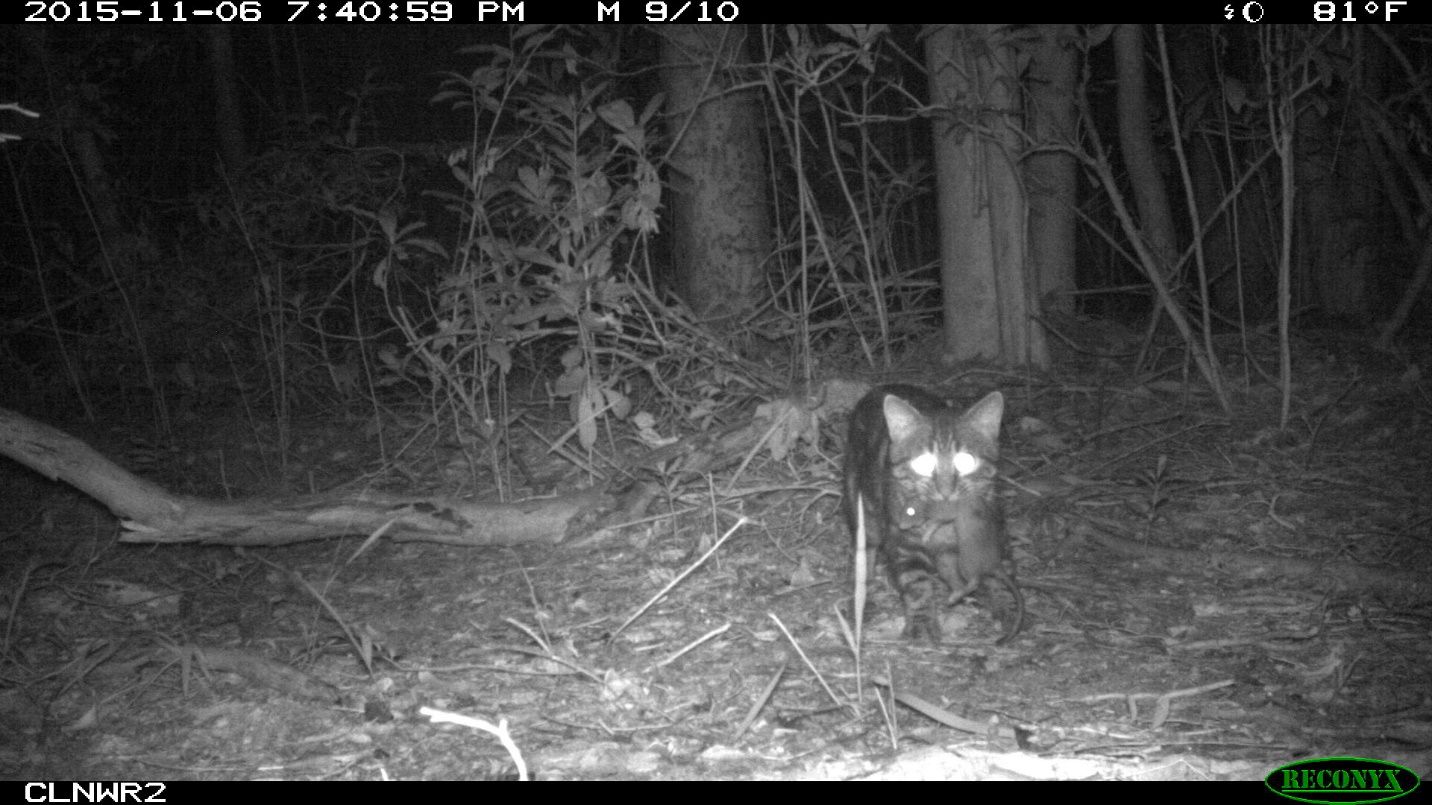
Credit: United States Fish and Wildlife Service
Did you know?
Today, more than 1700 supplemental woodrat nest structures have been installed across protected areas in northern Key Largo to aid in woodrat recovery (Figure 6). Many of these structures also serve as monitoring points to help regularly gauge the population.
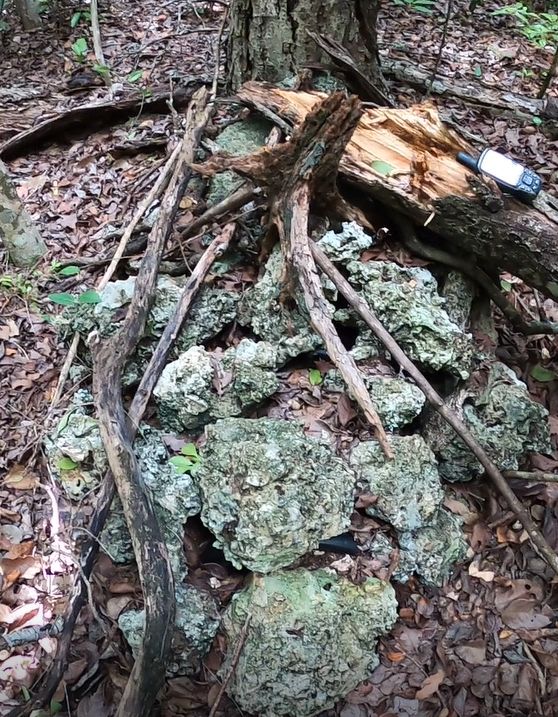
Credit: Brandon McDonald
Fast Facts
- Despite their common name, Key Largo woodrats are only distantly related to rats.
- Key Largo woodrats build nests on the ground but often forage for food in the tree canopy.
- Nests can be used by different generations of woodrats, particularly females, and enlarge over time.
- The first Burmese python captured in the Florida Keys was found because it consumed a radio-collared Key Largo woodrat.
- There is evidence that the insides of woodrat nests have distinct bacterial communities in which potential pathogens are low and antimicrobial-producing groups are high.
How you can help:
- Keep pets indoors or on a leash near protected areas in the Florida Keys.
- Do not feed stray cats.
- Report python sightings using the Florida Fish and Wildlife Conservation Commission (FWC) python hotline: 1-888-IVE-GOT-1.
- Support Key Largo woodrat conservation by supporting local, state, and federal agencies.
Selected References
Alligood, C. A., C. J. Wheaton, A. J. Deneault, R. C. Carlson, and A. Savage. 2009. “Behavioral Predictors of Copulation in Captive Key Largo Woodrats (Neotoma floridana smalli).” Behavioral Processes. 81 (2): 337–342. https://doi.org/10.1016/j.beproc.2008.08.003
Alligood, C. A., C. J. Wheaton, H. M. Forde, K. N. Smith, A. J. Daneault, R. C. Carlson, and A. Savage. 2008. “Pup Development and Maternal Behavior in Captive Key Largo Woodrats (Neomtoma floridana smalli).” Zoo Biology. 27:394–405. https://doi.org/10.1002/zoo.20205
Cove, M. V., T. R. Simons, B. Gardner, A. S. Maurer, and A. F. O’Connell. 2017. “Evaluating Nest Supplementation as a Recovery Strategy for the Endangered Rodents of the Florida Keys.” Restoration Ecology. 25 (2): 253–260. https://doi.org/10.1111/rec.12418
Cove, M. V., and A. S. Maurer. 2019. “Home Decorating by an Endangered Ecosystem Engineer.” Frontiers in Ecology and the Environment. 17 (4): 231. https://doi.org/10.1002/fee.2040
Cove, M. V., T. R. Simons, B. Gardner, and A. F. O’Connell. 2019. “Towards Recovery of an Endangered Island Endemic: Distributional and Behavioral Responses of Key Largo Woodrats Associated with Exotic Predator Removal.” Biological Conservation. 237:423–429. https://doi.org/10.1016/j.biocon.2019.07.032
Goodyear, N. C. 1989. “Studying Fine-Scale Habitat Use in Small Mammals.” Journal of Wildlife Management. 53 (4): 941–946. https://doi.org/10.2307/3809592
Hersh, S. L. 1981. “Ecology of the Key Largo Woodrat (Neotoma floridana smalli).” Journal of Mammalogy. 62 (1): 202–206. https://doi.org/10.2307/1380498
Humphrey, S. R. 1992. “Key Largo Woodrat.” Pp. 119–130. in Rare and Endangered Biota of Florida. Vol. I. University Press of Florida, Gainesville, FL, USA.
Kanine, J. M., S. B. Castleberry, M. T. Megnak, and C. Winchester. 2015. “Seasonal Variation in Composition of Key Largo Woodrat (Neotoma floridana smalli) Diets.” Southeastern Naturalist. 14 (2): 405–414. https://doi.org/10.1656/058.014.0220
McCleery, R. A. 2003. “Aspects of Key Largo Woodrat Ecology.” [Masters thesis]. 83p. Texas A&M University. https://hdl.handle.net/1969.1/24
McCleery, R. A., J. A. Hostetler, and M. K. Oli. 2014. “Better off in the Wild? Evaluating a Captive Breeding and Release Program for the Recovery of an Endangered Rodent.” Biological Conservation. 169:198–205. https://doi.org/10.1016/j.biocon.2013.11.026
McDonald, B. M., C. Baruzzi, M. V. Cove, R. A. McCleery, and M. A. Lashley. 2023. “Simulated Extreme Climate Event Alters a Plant Frugivore Mutualism.” Forest Ecology and Management. 545c: 121294. https://doi.org/10.1016/j.foreco.2023.121294
Sherman, H. B. 1955. “Description of a New Race of Woodrat from Key Largo, Florida.” Journal of Mammalogy. 36:113–120. https://doi.org/10.2307/1375731
Small, J. K. 1923. “Green Deserts and Dead Gardens.” Journal of the New York Botanical Garden. 24 (286): 215.
Terrell, S. P., F. C. Origgi, and D. Agnew. 2012. “Glomerulonephropathy in Aged Captive Key Largo Woodrats (Neotoma floridana smalli).” Veterinary Pathology. 49 (4): 710–716. https://doi.org/10.1177/0300985811404711
Thoemmes, M. S., and M. V. Cove. 2020. “Bacterial Communities in the Natural and Supplemental Nests of an Endangered Ecosystem Engineer.” Ecosphere. e03239. https://doi.org/10.1002/ecs2.3239
Wood, P. B. 2008. “Woodrat Population Dynamics and Movement Patterns.” Pp. 45–62 in The Allegheny Woodrat , edited by J. D. Peles and J. Wright. Springer, New York, NY, USA. https://doi.org/10.1007/978-0-387-36051-5_3
U.S. Fish and Wildlife Service. (2015). Status of the Species – Key Largo Woodrat. Atlanta, Georgia, USA.